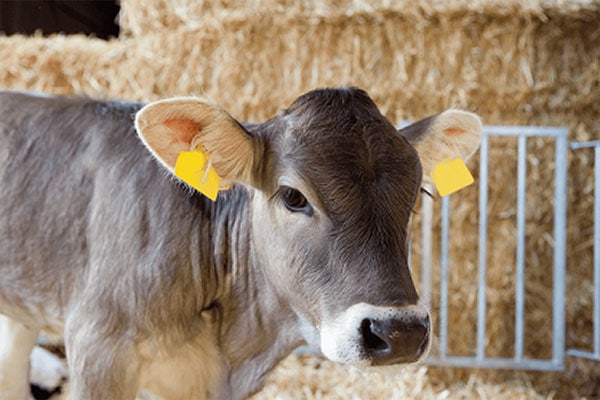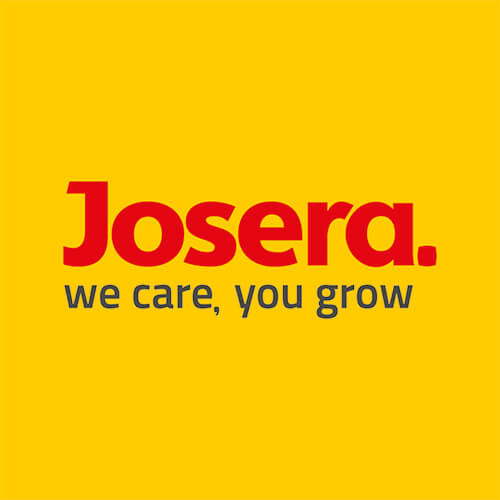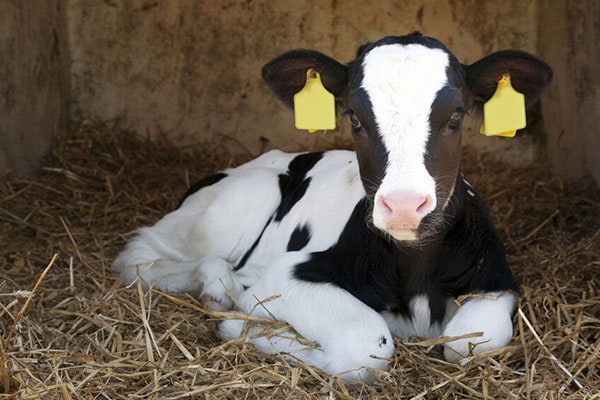Table of Contents:
Hygiene
Many positive influential factors help to keep the calf healthy. These include stress-free housing on straw, sufficient supply of colostrum and a clean drinking trough. However, when the animals are housing in an igloo or in pens in the stall, the most important factor is often neglected: hygiene. The practical farmer usually only sees consistent cleaning and disinfection in the pig and poultry area. However, finding coccidia, cryptosporidium or salmonella in the cattle area is no longer rare. The same high hygiene requirements therefore apply to the highly sensitive age group of young calves in order to prevent diseases.
Considering to this, it is important to first have a look at the ‘problem areas’ in calf rearing.
There are three critical areas in calf rearing, which are discussed in more detail below.
Birthing hygiene
The area of birthing hygiene is in a grey zone. Strictly speaking, it starts with the feeding of the pregnant or dry cows. Only a perfectly fed mother can provide the unborn calf with enough nutrients. In addition, fodder for the dry cow directly influences the colostrum quality. When calving, a cow that has become fat will have more problems with difficult birthing than a cow in good physical condition. A further critical point is the topic of birthing assistance. Of course, the farm manager must control whether everything goes smoothly at birth, i.e. that the calf is in the correct position and that no complications occur. Employees are often overzealous, but birthing assistance that is too early or too strong can harm the calf and the cow. You should often let nature take its course. During check-ups (and the afterbirth), it is essential to wash your hands so as not to introduce germs into the reproductive organs. Similarly, those assisting in the birthing must always be clean and preferably sterile.

Housing hygiene
Housing hygiene has many facets, from climate to disinfection of calf igloos. Depending on the type of housing, there are a variety of possibilities and hygiene obligations which must be observed. Individual igloos offer the advantage of consistently changing the location and therefore decimating ‘soil-borne’ pathogens. Nevertheless, the interior walls and partition must be cleaned after each calf if possible and debris removed from the previous tenant. Keeping wooden stables clean is more difficult. In this case, 100% cleanliness is just not possible because germs and dirt can stick in the cracks and wood fibres. Warming straw mattresses should be changed regularly. Scattered lime and flour-like hygiene products, which can often even be used in occupied stables, are helpful here.

Cleaning and disinfecting are the main factors in breaking the chain of infection (see figure 1). It depends on the right materials, the right concentration and the right duration of treatment. Here, you must pay attention to the manufacturer’s safety instructions. Housing hygiene also includes the (stall) climate. Outdoor calf stalls have proven themselves. The fear of too much cold or draught was not confirmed in the outdoor climate. It is important that the animals have the possibility to retreat with a microclimate. This also applies for calves that are housed in the cowshed. Modern dairy cattle stalls have large volumes of air – good for the cows, bad for the calves. Here in particular, protection against draughts and cold should be ensured by suspending or installing false ceilings. Regularly spreading fresh bedding with clean straw and controlling drinking troughs, as well as new roughage and concentrated feed every day round off the housing hygiene.
Impurities in colostrum
For evaluation of colostrum quality the density is usually measured and thus the immunoglobulin content gets determined indirectly. The Hygiene status as an important quality characteristic is usually not taken into account in the quality determination because the germ content cannot be determined easily. That’s why it’s even more important to pay special attention to hygiene while handling colostrum. Studies of the University of Applied Sciences South Westphalia show that the bacterial count in milk increases exponentially in the different stages from the udder to the drinking bucket if hygiene is inadequate.
At the beginning the immunoglobulins (type G) were still sufficiently present in the colostrum. However, an undersupply of immunoglobulins in the blood was found in 70% of the calves that had previously been fed with a sufficient amount of colostrum. After further investigations it became clear that large impurities already were formed in the milking can. Previous residues where not removed completely and thus offered a basis for germ multipilication which made the milk unsuitable for feeding.
Figure 1: shows the germ multiplication from the udder up to the bucket teat. Both in the transport bucket and in the bucket teat the germ counts increase.

Regularly rinsing the bucket or changing the drinking teat should not be a luxury. Even newborn calves require a new teat to prevent them from drinking too much water. The order of the trough also plays a role in breaking the infection chain. For bucket troughs, always start with the youngest animals and feed the older ones afterwards to prevent germs spreading from old to young, since young animals have a weaker immune system. On farms with larger calf herds, it is advisable to use a new bucket for each new calf, especially if the buckets are not cleaned properly after drinking but get stuck on the box or in the igloo.
What happens if previous work equipment is contaminated with germs?
- Immunoglobulins connect with pathogens which cannot be seperated subsequently and therefore are not available for the calf.
- Germs prevent the absorption of colostrum in the calves‘ intestine.
- Consequences can be diarrhoea as well as later respiratory diseases.
Conclusion
In every step of calf rearing attention should be payed to continuous cleaning.
Whether it’s the milking can, the transport bucket, the drinking bucket or the bucket teat, everything should be cleaned after every cycle to keep the germ contamination as low as possible and to ensure a sucessfull rearing.
Conclusion
All of these measures help to reduce the germ level. In the important area of calf rearing, animal observation and documentation of abnormalities is particularly important, especially in the case of changing care personnel. Through consistent hygiene management, you can sustainably reduce illnesses and save veterinary costs.
You might be interested in the following contents:
Dry Calf TMR
Successful calf-rearing is essential in today’s milk production, in order to obtain cows with higher yields and greater longevity in your barn. Next to milk replacer, which supports early metabolic programming, solid feed is an essential component for successful calf-rearing.
Respiratory diseases in calves
The cold season is upon us again. Respiratory diseases, such as coughs and pneumonia, are becoming increasingly common. The consequences are slower weight gain, additional expenditure for treatments and a longer rearing period.






 (No reviews available)
(No reviews available)
